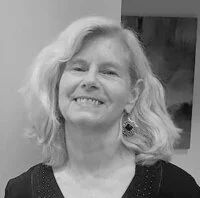Marky Kaufmann
"In the local woods, I found solace" to paraphrase Marky in her statement below I felt like this quote speaks to the feeling I get when I spend time with these images. They are indeed a comfort with a seeming relief from something sinister. The light and dark conflicted while giving an answer that is beautiful and serene. An influence, a suspicion. While looking at the works I do feel that escape to another world in a dreamlike landscape where trees embrace and nurture, where detailed foliage and bursts of light bring wonder. Within Marky's varied processes to produce these remarkable images we find that each step has purpose not only to bring us something beautiful but connect the artist with the process of seeking solace. To lift. Even the sharp presentation of elongated vertical images raises the viewers eye as if to the sky looking for something else. Perhaps an answer to a personal experience, an alleviation, a remedy.
- Steven Duede, Fine Art Photographer, Initiative founder
The combination of flowers, branches, leaves, and rocks that she used to create her “landscapes” somehow made sense to me. And her use of line, shape, pattern, texture, color, symmetry and asymmetry mesmerized me.
Landscapes and Prayers
Why do I make landscapes? The answer is twofold. In part, I make landscapes because the outside world always seemed less dangerous than the inside world of my childhood. If I ever felt safe, it was outside. And partially, it’s because my grandmother created “landscapes” of a sort – beautiful flower arrangements - that captured my young imagination.
In an interview with author Krista Tippett, the poet, Mary Oliver, describes her childhood by saying, “It was a very bad childhood for everybody, every member of the household, not just myself I think. And I escaped it, barely…. I got saved by the beauty of the natural world.” Oliver goes on to describe skipping school to spend her days in the forest near her home, reading books and writing poems.
I, too, had a “bad childhood,” to quote Oliver, although I grew up in an elegant house, in a fancy suburb. Being outside offered me an escape from family difficulties. In the local woods, I found solace, something I rarely found at home.
The story of these landscapes can also be attributed to my maternal grandmother, Ellen Gordon Allen, who lived in Japan at the end of World War II. While in Japan, she became a skilled practitioner of Ikebana flower arranging, and upon returning to the US, founded Ikebana International, an organization that promotes Japanese flower arranging and Japanese culture. As a child, I was completely captivated by the Asian art in my grandmother’s home, and by her flower arrangements. The combination of flowers, branches, leaves, and rocks that she used to create her “landscapes” somehow made sense to me. And her use of line, shape, pattern, texture, color, symmetry and asymmetry mesmerized me.
So I, too, make landscapes of a sort. These images begin as silver prints that I bleach with potassium ferricyanide, utilizing various tools such as brushes and funnels. The bleach allows me to create a unique world. Within these landscapes, I find peace, and great comfort.
Marky Kaufmann
Bio
Marky Kauffmann is a graduate of Boston University and the New England School of Photography. She has been working as a fine art photographer, educator, and curator for more than thirty years. She is the recipient of numerous awards, including two Massachusetts Cultural Council Artist Fellowship Finalist grants. Most recently, she won First Place in Soho Photo Gallery’s National Alternative Processes Competition, and was a finalist in the 7th Edition Julia Margaret Cameron Worldwide Gala Awards in three categories, including fine art, portraiture, and landscapes photography. Last summer, Kauffmann garnered an Honorable Mention in the Danforth Museum’s Art Annual Competition, juried by curator Jessica Roscio, and was part of Photolucida’s Critical Mass Top 200.
Kauffmann has been a guest curator at several Boston-area school galleries. Her first curatorial endeavor, Five After Five, featured five New England School of Photography graduates who were making art five years after graduation. Last year she helped curate Veiled Rebellion, an exhibit featuring the work of Pulitzer Prize winning photographer, Lynsey Addario, at Milton Academy’s Nesto Gallery. Currently, Kauffmann’s exhibit, Outspoken: Seven Women Photographers is on display at the de Menil Gallery at Groton School in Groton, MA.
Kauffmann is a passionate educator who has taught photography at numerous secondary schools, including Buckingham Brown and Nichols School, Shady Hill School, Dana Hall School, Milton Academy and Weston High School. She also spent twenty years teaching photography to adults as part of the New England School of Photography’s Evening Workshop Program. Currently she teaches at Milton Academy’s Saturday Course. Kauffmann also serves as a corporator to the Griffin Museum of Photography’s Board of Directors.
Kauffmann is in love with photography. She believes discovering photography allowed her to finally find her voice. She utilizes traditional darkroom techniques, alternative processes, and digital technologies to create her unique images.
Kauffmann splits her time between her studio in Somerville, and her home in Shirley, MA, where she lives with her husband, Gordon Chase.











